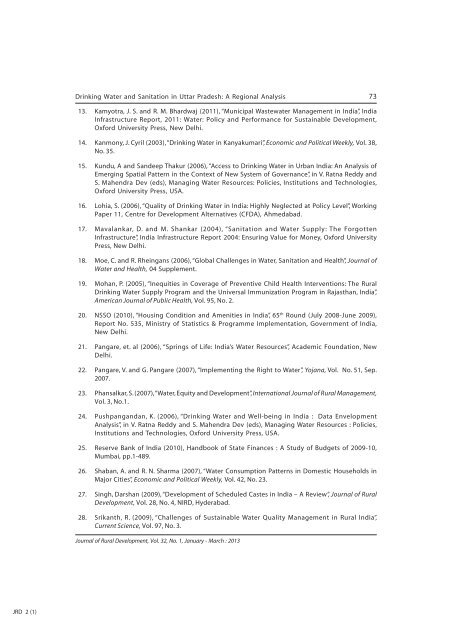January - March 2013 - National Institute of Rural Development
January - March 2013 - National Institute of Rural Development
January - March 2013 - National Institute of Rural Development
- No tags were found...
Create successful ePaper yourself
Turn your PDF publications into a flip-book with our unique Google optimized e-Paper software.
Drinking Water and Sanitation in Uttar Pradesh: A Regional Analysis 7313. Kamyotra, J. S. and R. M. Bhardwaj (2011), “Municipal Wastewater Management in India”, IndiaInfrastructure Report, 2011: Water: Policy and Performance for Sustainable <strong>Development</strong>,Oxford University Press, New Delhi.14. Kanmony, J. Cyril (2003), “Drinking Water in Kanyakumari”, Economic and Political Weekly, Vol. 38,No. 35.15. Kundu, A and Sandeep Thakur (2006), “Access to Drinking Water in Urban India: An Analysis <strong>of</strong>Emerging Spatial Pattern in the Context <strong>of</strong> New System <strong>of</strong> Governance”, in V. Ratna Reddy andS. Mahendra Dev (eds), Managing Water Resources: Policies, Institutions and Technologies,Oxford University Press, USA.16. Lohia, S. (2006), “Quality <strong>of</strong> Drinking Water in India: Highly Neglected at Policy Level”, WorkingPaper 11, Centre for <strong>Development</strong> Alternatives (CFDA), Ahmedabad.17. Mavalankar, D. and M. Shankar (2004), “Sanitation and Water Supply: The ForgottenInfrastructure”, India Infrastructure Report 2004: Ensuring Value for Money, Oxford UniversityPress, New Delhi.18. Moe, C. and R. Rheingans (2006), “Global Challenges in Water, Sanitation and Health”, Journal <strong>of</strong>Water and Health, 04 Supplement.19. Mohan, P. (2005), “Inequities in Coverage <strong>of</strong> Preventive Child Health Interventions: The <strong>Rural</strong>Drinking Water Supply Program and the Universal Immunization Program in Rajasthan, India”,American Journal <strong>of</strong> Public Health, Vol. 95, No. 2.20. NSSO (2010), “Housing Condition and Amenities in India”, 65 th Round (July 2008-June 2009),Report No. 535, Ministry <strong>of</strong> Statistics & Programme Implementation, Government <strong>of</strong> India,New Delhi.21. Pangare, et. al (2006), “Springs <strong>of</strong> Life: India’s Water Resources”, Academic Foundation, NewDelhi.22. Pangare, V. and G. Pangare (2007), “Implementing the Right to Water”, Yojana, Vol. No. 51, Sep.2007.23. Phansalkar, S. (2007), “Water, Equity and <strong>Development</strong>”, International Journal <strong>of</strong> <strong>Rural</strong> Management,Vol. 3, No.1.24. Pushpangandan, K. (2006), “Drinking Water and Well-being in India : Data EnvelopmentAnalysis”, in V. Ratna Reddy and S. Mahendra Dev (eds), Managing Water Resources : Policies,Institutions and Technologies, Oxford University Press, USA.25. Reserve Bank <strong>of</strong> India (2010), Handbook <strong>of</strong> State Finances : A Study <strong>of</strong> Budgets <strong>of</strong> 2009-10,Mumbai, pp.1-489.26. Shaban, A. and R. N. Sharma (2007), “Water Consumption Patterns in Domestic Households inMajor Cities”, Economic and Political Weekly, Vol. 42, No. 23.27. Singh, Darshan (2009), “<strong>Development</strong> <strong>of</strong> Scheduled Castes in India – A Review”, Journal <strong>of</strong> <strong>Rural</strong><strong>Development</strong>, Vol. 28, No. 4, NIRD, Hyderabad.28. Srikanth, R. (2009), “Challenges <strong>of</strong> Sustainable Water Quality Management in <strong>Rural</strong> India”,Current Science, Vol. 97, No. 3.Journal <strong>of</strong> <strong>Rural</strong> <strong>Development</strong>, Vol. 32, No. 1, <strong>January</strong> - <strong>March</strong> : <strong>2013</strong>JRD 2 (1)
















